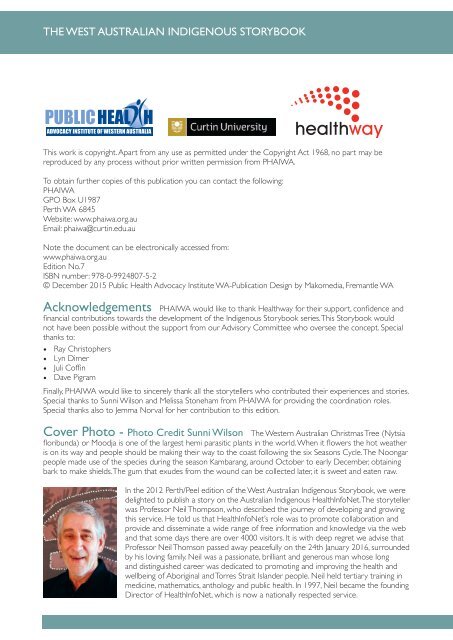INDIGENOUS STORYBOOK
bbj6MXa
bbj6MXa
Create successful ePaper yourself
Turn your PDF publications into a flip-book with our unique Google optimized e-Paper software.
THE WEST AUSTRALIAN <strong>INDIGENOUS</strong> <strong>STORYBOOK</strong><br />
This work is copyright. Apart from any use as permitted under the Copyright Act 1968, no part may be<br />
reproduced by any process without prior written permission from PHAIWA.<br />
To obtain further copies of this publication you can contact the following:<br />
PHAIWA<br />
GPO Box U1987<br />
Perth WA 6845<br />
Website: www.phaiwa.org.au<br />
Email: phaiwa@curtin.edu.au<br />
Note the document can be electronically accessed from:<br />
www.phaiwa.org.au<br />
Edition No.7<br />
ISBN number: 978-0-9924807-5-2<br />
© December 2015 Public Health Advocacy Institute WA-Publication Design by Makomedia, Fremantle WA<br />
Acknowledgements PHAIWA would like to thank Healthway for their support, confidence and<br />
financial contributions towards the development of the Indigenous Storybook series. This Storybook would<br />
not have been possible without the support from our Advisory Committee who oversee the concept. Special<br />
thanks to:<br />
• Ray Christophers<br />
• Lyn Dimer<br />
• Juli Coffin<br />
• Dave Pigram<br />
Finally, PHAIWA would like to sincerely thank all the storytellers who contributed their experiences and stories.<br />
Special thanks to Sunni Wilson and Melissa Stoneham from PHAIWA for providing the coordination roles.<br />
Special thanks also to Jemma Norval for her contribution to this edition.<br />
Cover Photo - Photo Credit Sunni Wilson The Western Australian Christmas Tree (Nytsia<br />
floribunda) or Moodja is one of the largest hemi parasitic plants in the world. When it flowers the hot weather<br />
is on its way and people should be making their way to the coast following the six Seasons Cycle. The Noongar<br />
people made use of the species during the season Kambarang, around October to early December, obtaining<br />
bark to make shields. The gum that exudes from the wound can be collected later, it is sweet and eaten raw.<br />
In the 2012 Perth/Peel edition of the West Australian Indigenous Storybook, we were<br />
delighted to publish a story on the Australian Indigenous HealthInfoNet. The storyteller<br />
was Professor Neil Thompson, who described the journey of developing and growing<br />
this service. He told us that HealthInfoNet’s role was to promote collaboration and<br />
provide and disseminate a wide range of free information and knowledge via the web<br />
and that some days there are over 4000 visitors. It is with deep regret we advise that<br />
Professor Neil Thomson passed away peacefully on the 24th January 2016, surrounded<br />
by his loving family. Neil was a passionate, brilliant and generous man whose long<br />
and distinguished career was dedicated to promoting and improving the health and<br />
wellbeing of Aboriginal and Torres Strait Islander people. Neil held tertiary training in<br />
medicine, mathematics, anthology and public health. In 1997, Neil became the founding<br />
Director of HealthInfoNet, which is now a nationally respected service.


